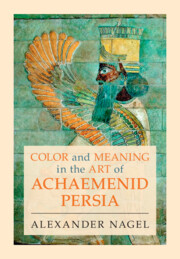Book contents
- Color and Meaning in the Art of Achaemenid Persia
- Color and Meaning in the Art of Achaemenid Persia
- Copyright page
- Contents
- Figures
- Acknowledgments
- Introduction: The Most Beautiful Blues
- Chapter One Defining Polychromies
- Chapter Two Historiographical Overview, Part I: Approaching Achaemenid Persian Polychromies in the Nineteenth Century – Ancient Literary Testimony and Modern Discourses
- Chapter Three Historiographical Overview, Part II: Approaching Achaemenid Persian Polychromies in the Twentieth Century
- Chapter Four Uncomfortable Truths: Challenges of Documenting and Preserving Achaemenid Persian Polychromies
- Chapter Five A Discussion: Aspects of Nonverbal Communication in the Achaemenid Persian Empire
- Chapter Six Concluding Contemplations
- Bibliography
- Index
Chapter One - Defining Polychromies
Published online by Cambridge University Press: 24 August 2023
- Color and Meaning in the Art of Achaemenid Persia
- Color and Meaning in the Art of Achaemenid Persia
- Copyright page
- Contents
- Figures
- Acknowledgments
- Introduction: The Most Beautiful Blues
- Chapter One Defining Polychromies
- Chapter Two Historiographical Overview, Part I: Approaching Achaemenid Persian Polychromies in the Nineteenth Century – Ancient Literary Testimony and Modern Discourses
- Chapter Three Historiographical Overview, Part II: Approaching Achaemenid Persian Polychromies in the Twentieth Century
- Chapter Four Uncomfortable Truths: Challenges of Documenting and Preserving Achaemenid Persian Polychromies
- Chapter Five A Discussion: Aspects of Nonverbal Communication in the Achaemenid Persian Empire
- Chapter Six Concluding Contemplations
- Bibliography
- Index
Summary
In this chapter I lay out a theoretical framework by providing a definition of polychromy as used in this book. I review the development of polychromy studies and deal specifically with the early stages of the modern reception of ancient western Asian polychromies. I investigate and explore how the surface of ancient stone monuments, particularly of Assyria, has been encountered by antiquarians, archaeologists, and museum curators and how the polychromies have inspired, been displayed, and appreciated since the nineteenth century. This is not an exhaustive survey. Within this framework, however, issues of competing definitions, aesthetic debates and movements, as well as aspects of influence from polychromy debates in relation to other ancient civilizations such as Egypt, Greece, and Rome, loom large. At the more recent end of this engagement stands Batchelor’s (2000) Chromophobia. Batchelor argued that nineteenth-century European thought laid much of the ground for a fear that color would eventually “take over” the values of western civilization. He suggested that it was in the nineteenth century that color became “forcefully” excluded and abolished from a presumed universal western mindset, because it was seen as a “corruption of culture” implicitly tied to “the feminine, the oriental, the primitive, the infantile …”1 It is mainly for this reason that for many decades, scholars trained in a European-American tradition, and increasingly scholars trained around the world, have conceptualized and presented the past as predominantly “white.”
- Type
- Chapter
- Information
- Color and Meaning in the Art of Achaemenid Persia , pp. 20 - 57Publisher: Cambridge University PressPrint publication year: 2023

